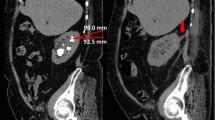Abstract
Background
Few Western studies have focused on percutaneous techniques using percutaneous transhepatic choledochoscopy (PTHC) and holmium:yttrium–aluminum–garnet (YAG) laser to ablate biliary calculi in patients unable or unwilling to undergo endoscopic or surgical removal of the calculi. The authors report the efficacy of the holmium:YAG laser in clearing complex biliary calculi using percutaneous access techniques.
Methods
This study retrospectively reviewed 13 non-Asian patients with complex secondary biliary calculi treated percutaneously using holmium:YAG laser. Percutaneous access was accomplished via left, right, or bilateral hepatic ducts and upsized for passage of a 7-Fr video choledochoscope. Lithotripsy was performed under choledochoscopic vision using a holmium:YAG laser with 200- or 365-μm fibers generating 0.6 to 1.0 joules at 8 to 15 Hz. Patients underwent treatment until stone clearance was confirmed by PTHC. Downsizing and subsequent removal of percutaneous catheters completed the treatment course.
Results
Seven men and six women with an average age of 69 years underwent treatment. All the patients had their biliary tract stones cleared successfully. Of the 13 patients, 3 were treated solely as outpatients. The average length of percutaneous access was 108 days. At this writing, one patient still has a catheter in place. The average number of holmium:YAG laser treatments required for stone clearance was 1.6, with no patients requiring more than 3 treatments. Of the 13 patients, 8 underwent a single holmium:YAG laser treatment to clear their calculi. Prior unsuccessful attempts at endoscopic removal of the calculi had been experienced by 7 of the 13 patients. Five patients underwent percutaneous access and subsequent stone removal as their sole therapy for biliary stones. Five patients were cleared of their calculi after percutaneous laser ablation of large stones and percutaneous basket retrieval of the remaining stone fragments. There was one complication of pain requiring admission, and no deaths.
Conclusions
The use of PTHC with holmium:YAG laser ablation is safe and efficacious, but requires prolonged biliary access and often multiple procedures to ensure clearance of all calculi.





Similar content being viewed by others
References
Bland KI, Jones RS, Maher JW, Cotton PB, Pennell TC, Amerson JR, Munson JL, Berci G, Fuchs GJ, Way LW (1989) Extracorporeal shock wave lithotripsy of bile duct calculi: an interim report of the Dornier U.S. Bile Duct Lithotripsy Prospective Study. Ann Surg 209: 743–753
Chen CH, Huang MH, Yang JC, Yang CC, Yeh YH, Wu HS, Chou DA, Yueh SK, Nien CK (2005) Reappraisal of percutaneous transhepatic cholangioscopic lithotomy for primary hepatolithiasis. Surg Endosc 19: 505–509
Cheung MT, Wai SH, Kwok PCH (2003) Percutaneous transhepatic choledochoscopic removal of intrahepatic stones. Br J Surg 90: 1409–1415
Das AK, Chiura A, Conlin MJ, Eschelman D, Bagley DH (1998) Treatment of biliary calculi using holmium:yttrium-aluminum-garnet laser. Gastroint Endosc 48: 207–209
Ell C, Lux G, Hochberger J, Muller D, Demling L (1988) Laser lithotripsy of common bile duct stones. Gut 29: 746–751
Harz C, Henkel TO, Kohrmann KU, Pimentel F, Alken P, Manegold BC (1991) Extracorporeal shock wave lithotripsy and endoscopy: combined therapy for problematic bile duct stones. Surg Endosc 5: 196–199
Huang MH, Chen CH, Yang JC, Yang CC, Yeh YH, Chou DA, Mo LR, Yueh SK, Nien CK (2003) Long-term outcome of percutaneous transhepatic cholangioscopic lithotomy for hepatolithiasis. Am J Gastroenterol 98: 2655–2662
Jan YY, Chen MF (1995) Percutaneous transhepatic choledochoscopic lithotomy for hepatolithiasis: long-term results. Gastrointest Endosc. 42: 1–4
Lee SK, Seo DW, Myung SJ, Park ET, Lim BC, Kim HJ, Yoo KS, Park HJ, Joo YH, Kim MH, Min YI (2001) Percutaneous transhepatic choledochoscopic treatment for hepatolithiasis: an evaluation of long-term results and risk factors for recurrence. Gastrointest Endosc 53: 318–323
Orii K, Nakahara A, Takase Y, Ozaki A, Sakita T, Iwasaki Y (1981) Choledocholithotomy by YAG laser with a choledochofiberscope: case reports of two patients. Surgery 90: 120–122
Shamamian P, Grasso M (2004) Management of complex biliary tract calculi with a holmium laser. J Gastrointest Surg 8: 191–199
Sugawa C, Wiencek RG Jr (1988) Endoscopic retrograde sphincterotomy in the treatment of biliary tract disease. Am Surg 54: 412–418
Teichman JMH, Schwesinger WH, Lackner J, Cossman RM (2001) Holmium:YAG laser lithotripsy for gallstones: a preliminary report. Surg Endosc 15: 1034–1037
White DM, Correa RJ, Gibbons RP, Ball TJ, Kozarek RJ, Thirlby RC (1998) Extracorporeal shock wave lithotripsy for bile duct calculi. Am J Surg 175: 10–13
Author information
Authors and Affiliations
Corresponding author
Rights and permissions
About this article
Cite this article
Hazey, J.W., McCreary, M., Guy, G. et al. Efficacy of percutaneous treatment of biliary tract calculi using the holmium:YAG laser. Surg Endosc 21, 1180–1183 (2007). https://doi.org/10.1007/s00464-006-9168-6
Received:
Revised:
Accepted:
Published:
Issue Date:
DOI: https://doi.org/10.1007/s00464-006-9168-6




